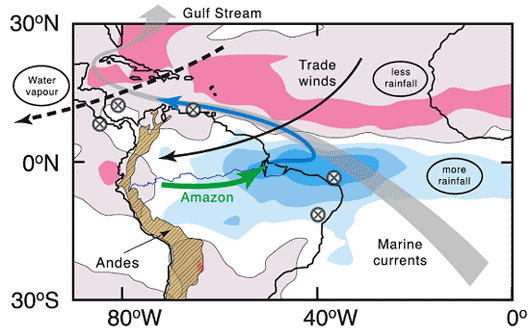Panama And the Deep Atlantic Circulation...
Some past major climatic episodes had a deep impact on the Atlantic circulation. A recent work conducted by the team ?Organic Geochemistry and Stable Isotope? at CEREGE(1) has demonstrated that this type of climatic perturbation is amplified by the tropical water cycle (positive feedback). This study will help to better understand, and hence to better predict beyond the centuries, the present-day climate change impact on the oceanic circulation. This study is published in today's issue of Nature.
The Atlantic Ocean circulation reduction induced by the present-day global warming impact is generally accepted, even if uncertainties concerning the amplitude and the rate of future changes remain (see the Toolbox). On the other hand, the response of the tropics to rapid variations in the ocean-atmosphere coupling and its impact on the oceanic circulation remain largely unknown.
Only the paleoclimatic approach is able to document this type of environmental variability. In fact, it is generally accepted that oceanographic perturbations were frequent during the last glacial period. In particular, the so-called Heinrich events are characterized by the deep Atlantic circulation collapse triggered by enhanced freshwater fluxes to the ocean, which in turn were caused by icebergs melting.
Paleoclimatic archives such as lake and marine sediments, polar ice sheets and stalagmites have clearly recorded these rapid, large impact climatic changes that were intimately linked to harsh changes in deep oceanic circulation. The major temperature variations are observed in the North Atlantic area, but recent paleoclimatic studies also indicate an impact at a global scale, and particularly on the water cycle. These climatic variations are accompanied by latitudinal shifts of the climatic equator that separate the trade winds systems of both hemispheres (Intertropical Convergence Zone).
One key region of this system is Central America, a thin continental area that separates the Atlantic and Pacific oceans. In the Atlantic sector, surface waters are marked by intense evaporation that acts to increase their salinity. The water vapour is then transferred via the trade winds toward the Pacific where it is deposited by the way of intense rainfall, hence diminishing the surface water salinity. This water vapour transfer between both oceanic basins attains several hundreds of thousands cubic meters per second. This huge freshwater flux permanently maintains a salinity contrast between both oceans. The tropical Atlantic surface waters are then transported toward northern high latitudes, via the Gulf Stream, where they warm the atmosphere before dipping in the abyss at convection sites that are situated in Norwegian, Greenland and Labrador Seas. These newly formed deep waters then spread within the World Ocean and partly purge the North Atlantic salt excess.
From numerous geochemical indicators measured on marine sediments that were retrieved in 2002 by the French research vessel Marion Dufresne within the western Panama Basin, we have reconstructed sea surface salinities, precisely where the freshwater that originates from the Atlantic is deposited. By comparing our results to other studies conducted in the Atlantic sector and in South America, we have shown that during cold climatic crises, the moisture-loaded trade winds have migrated southward and hence could not have blown across the Andean Cordillera. One part of the rainfall that usually freshens the Eastern Pacific was deposited within the Amazonian Basin drainage (see the Figure). This feedback, within which the ocean, the atmospheric circulation, the topography and the riverine network interact, acts to re-inject freshwater within the Atlantic Ocean, and consequently to lower its surface water salinity.
Our new study shows that a link exists between the tropical hydrology and the deep Atlantic circulation, that modulates the climatic variability above and around the North Atlantic area (and specifically in Europe). This new climatic feedback could be studied by modelling experiments coupling the atmosphere and the ocean. The available model simulations suggest that this phenomenon is important. Complementary calculations will have to be realized with a spatial resolution sufficient to realistically represent the topography of mountain chains in the tropical zone.
Figure: Map of rainfall mean anomaly simulated by models after the deep circulation have collapsed (more rainfall in blue, less rainfall in red ; adapted from Stouffer et al., 2006). The dotted arrow indicates the present-day water vapour transport across
Which behaviour for the deep Atlantic circulation?
The climatic models perturbed by greenhouse gases generally respond by a progressive lowering of the deep meridional circulation intensity. Some simulations indicate that in 2100 A.D. (or even later), the oceanic circulation also may tip over, with a sill effect, in another stable mode of deep circulation even more sluggish. In parallel of modelling experiments, oceanographic data available for the last 50 years suggest that hydrological changes have already occurred in North Atlantic. Moreover, oceanographers have evidenced a lowering of water fluxes transported by surface and deep currents. Satellite data indicate recent acceleration of Greenland ice melting. Even if large uncertainties remain, it seems that the risks of a lowering and/or turning over of the oceanic circulation beyond the horizon of this century has to be seriously taken into account.
(1) Centre européen de recherche et d'enseignement des géosciences de l'environnement (CNRS, Universités Aix-Marseille 3 et 1, IRD et Collège de France)
Reference :
Leduc G., Vidal L., Tachikawa K., Rostek F., Sonzogni C., Beaufort L., Bard E., Moisture transport across






